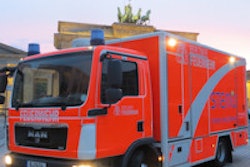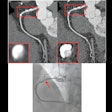
TORONTO - There is no survival advantage to using CT over chest x-ray when monitoring patients who have undergone resection for pathologic stage I non-small cell lung cancer (NSCLC), according to a retrospective analysis presented at the American Association for Thoracic Surgery (AATS) annual meeting.
Dr. Traves Crabtree, an associate professor of surgery at Washington University School of Medicine, said that multiple imaging guidelines have been disseminated for imaging surveillance of patients with NSCLC after surgery. In addition, data from the National Lung Screening Trial showed there could be a survival advantage for routine low-dose CT scans compared to routine chest radiography for patients at elevated risk of developing a first primary lung cancer.
Still, many studies have been unable to show a survival benefit for the use of CT in NSCLC patients, Crabtree said.
"CT often results in earlier time to diagnosis than chest x-ray, but most studies have not been able to demonstrate a significant difference in survival or cancer-specific survival," he said. "We instinctively hypothesized that the use of CT would result in an earlier time to diagnosis of recurrence and that this would translate to improvement in survival."
Crabtree and colleagues conducted a single-center analysis, looking at patients who had undergone resection between January 2000 and April 2013. Follow-up consisted of a routine history and physical examination as well as imaging, with the choice of modality being left to the treating physician.
"We chose just pathological stage I lung cancer to provide cleaner data than we would have had if we included stage II or III disease," Crabtree told AATS attendees.
The researchers evaluated 554 patients: 232 had undergone CT postoperatively, and 322 had chest x-ray after surgery. They found no statistically significant difference in postoperative survival at five years, with survival at 67.8% for the CT group versus 74.8% for chest radiography (p = 0.603).
There was also no statistically significant difference between the two modalities in the detection of successive lung malignancies: 27% for CT versus 22% for chest radiography (p = 0.19). Crabtree and colleagues did find a statistically significant difference in the mean time from surgery to diagnosis of successive malignancy, favoring the use of CT: 1.93 years for CT versus 2.56 years for chest x-ray (p = 0.046).
There was no statistically significant difference between the study arms in terms of curative intent, with 41% of malignancies being treated with curative intent in the CT arm and 40% in the chest x-ray arm. Nor was use of imaging modality linked to improved survival (p = 0.958).
"CT resulted in an earlier time to diagnosis compared to chest x-ray, but there was no difference in overall survival and no difference in cancer-specific survival," Crabtree said.
The two groups were not identical with respect to characteristics such as tumor stage, type of resection, and use of adjuvant therapy, but the researchers addressed those differences by employing propensity score matching, according to Crabtree.
One study limitation is that it may not have had sufficient power to detect a difference in overall survival between the two groups. The researchers did note a difference trending toward significance when they compared patients with asymptomatic versus those with symptomatic presentation of successive malignancy, with a median 4.98 years for CT, compared with 3.23 years for radiography (p = 0.070).
With CT, nine patients (4%) had false-positive surveillance imaging that led to an invasive diagnostic procedure, while just one patient (0.3%) who had undergone chest x-ray imaging had an invasive diagnostic procedure (p = 0.002), which Crabtree noted as an example of inappropriate imaging.
In an interview with AuntMinnie.com, he said the findings do not suggest that chest x-ray should supplant CT as a surveillance tool. Rather, the data create an opportunity for a randomized study that would look at multiple types of imaging modalities used for surveillance in this patient population.
"We would like to see if it [use of CT] truly affects survival, rather than make assumptions based on technology," he said.



















